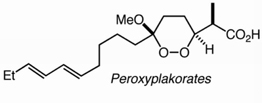Department of Chemistry
Date of this Version
8-2010
Abstract
Consumption of plant sterols or stanols (collectively referred to as phytosterols) and their esters results in decreased lowdensity lipoprotein cholesterol, which is associated with decreased atherosclerotic risk. The mechanisms by which phytosterols impart their effects, however, are incompletely characterized. The objective of the present study is to determine if pancreatic cholesterol esterase (PCE; EC 3.1.1.13), the enzyme primarily responsible for cholesterol ester hydrolysis in the digestive tract, is capable of hydrolyzing various phytosterol esters and to compare the rates of sterol ester hydrolysis in vitro. We found that PCE hydrolyzes palmitate, oleate and stearate esters of cholesterol, stigmasterol, stigmastanol and sitosterol. Furthermore, we found that the rate of hydrolysis was dependent on both the sterol and the fatty acid moieties in the following order of rates of hydrolysis: cholesterol > (sitosterol = stigmastanol) > stigmasterol; oleate > (palmitate = stearate). The addition of free phytosterols to the system did not change hydrolytic activity of PCE, while addition of palmitate, oleate or stearate increased activity. Thus, PCE may play an important but discriminatory role in vivo in the liberation of free phytosterols to compete with cholesterol for micellar solubilization and absorption.


Comments
Published in The Journal of Nutritional Biochemistry 21:8 (August 2010), pp. 736-740; doi: 10.1016/j.jnutbio.2009.04.008 Copyright © 2010 Elsevier Inc. Used by permission.